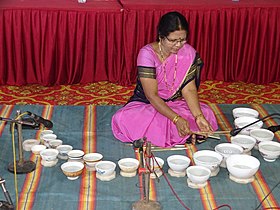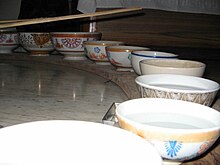| This article needs additional citations for verification. Please help improve this article by adding citations to reliable sources. Unsourced material may be challenged and removed. Find sources: "Jal tarang" – news · newspapers · books · scholar · JSTOR (August 2023) (Learn how and when to remove this message) |
 Vidushi Shashikala Dani playing the jalatarang Vidushi Shashikala Dani playing the jalatarang | |
| Percussion instrument | |
|---|---|
| Other names |
|
| Classification | Percussion |
| Hornbostel–Sachs classification | 111.242.11 (Resting bells whose opening faces upward) |
| Developed | 4th–6th centuries CE |
| Musicians | |
The jal tarang (Hindi: जलतरंग) is a melodic percussion instrument that originates from the Indian subcontinent. It consists of a set of ceramic or metal bowls filled with water. The bowls are played by striking the edge with beaters, one in each hand.
History
The earliest mention of the jal tarang is found in Vatsyayana's Kamasutra, as playing on musical glasses filled with water. Jal tarang was also mentioned in the medieval Sangeet Parijaat text, which categorized the instrument under Ghan-Vadya (idiophonic instruments in which sound is produced by striking a surface, also called concussion idiophones.) The SangeetSaar text considers 22 bowls to be a complete jal tarang and 15 to be of mediocre status. The bowls, of varying sizes, are made of either bronze or porcelain. Jal tarang was also called jal-yantra in medieval times, and poets of the Krishna cult (also called Ashtachhap poets) have mentioned the instrument.
Jal tarang means "waves in water", and it indicates motion of sound created or modified with the aid of water. The traditional instrument is used in Indian classical music.
Details

Water is poured into the bowls, and the pitch is changed by adjusting the volume of water. The number of bowls depends on the melody being played. The bowls are mostly arranged in a semicircle in front of the player, who can then reach them all easily. The player softly hits the edges of the bowls with a wooden stick to produce sound.
See also
References
- "The Kama Sutra of Vatsyayana", ReadCentral.com.
- Lalmani Misra (1973). Bharatiya Sangeet Vadya. Bhāratīya Jñānapīṭha. ISBN 81-263-0727-7.
External links
![]() Media related to Jal tarang at Wikimedia Commons
Media related to Jal tarang at Wikimedia Commons
| Indian musical instruments | |
|---|---|
| Wind (Sushir) | |
| Plucked Stringed (Tat) | |
| Bowed Stringed (Vitat) | |
| Membranous Percussion (Avanaddh) | |
| Non-Membranous Percussion (Ghan) | |
| Other | |
| Historical/possibly extinct | |
| Water instruments | |
|---|---|